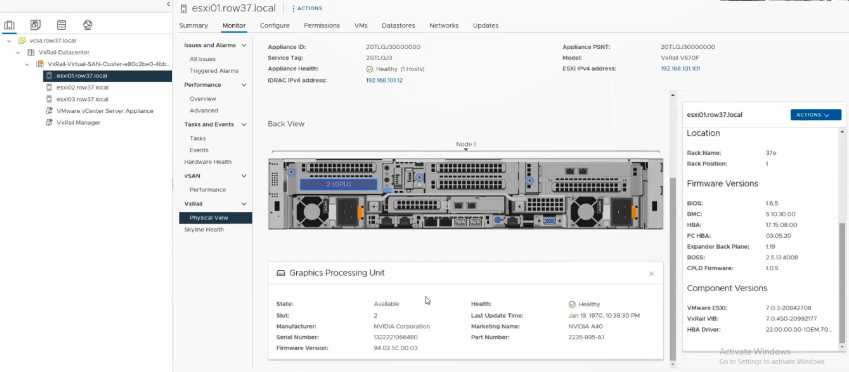

What’s New: VMware Cloud Foundation 4.5.1 on Dell VxRail 7.0.450 Release and More!
Thu, 11 May 2023 15:55:52 -0000
|Read Time: 0 minutes
This latest Cloud Foundation (VCF) on VxRail release includes updated versions of software BOM components, a bunch of new VxRail platform enhancements, and some good ol’ under-the-hood improvements that lay the groundwork for future features designed to deliver an even better customer experience. Read on for the highlights…
VCF on VxRail operations and serviceability enhancements
View Nvidia GPU hardware details in VxRail Manager vCenter plugin ‘Physical View’ and VxRail API
Leveraging the power of GPU acceleration with VCF on VxRail delivers a lot of value to organizations looking to harness the power of their data. VCF on VxRail makes operationalizing infrastructure with Nvidia GPUs easier with native GPU visualization and details using the VxRail Manager vCenter Plugin ‘Physical View’ and VxRail API. Administrators can quickly gain deeper-level hardware insights into the health and details of the Nvidia GPUs running on their VxRail nodes, to easily map the hardware layer to the virtual layer, and to help improve infrastructure management and serviceability operations.
Figure 1 shows what this looks like.
Figure 1. Nvidia GPU visualization and details – VxRail vCenter Plugin ‘Physical View’ UI
Support for the capturing, displaying, and proactive Dell dial home alerting for new VxRail iDRAC system events and alarms
Introduced in VxRail 7.0.450 and available in VCF 4.5.1 on VxRail 7.0.450 are enhancements to VxRail Manager intelligent system health monitoring of iDRAC critical and warning system events. With this new feature, new iDRAC warning and critical system events are captured, and through VxRail Manager integration with both iDRAC and vCenter, alarms are triggered and posted in vCenter.
Customers can view these events and alarms in the native vCenter UI and the VxRail Manager vCenter Plugin Physical View which contains KB article links in the event description to provide added details and guidance on remediation. These new events also trigger call home actions to inform Dell support about the incident.
These improvements are designed to improve the serviceability and support experience for customers of VCF on VxRail. Figures 2 and 3 show these events as they appear in the vCenter UI ‘All Issues’ view and the VxRail Manager vCenter Plugin Physical View UI, respectively.
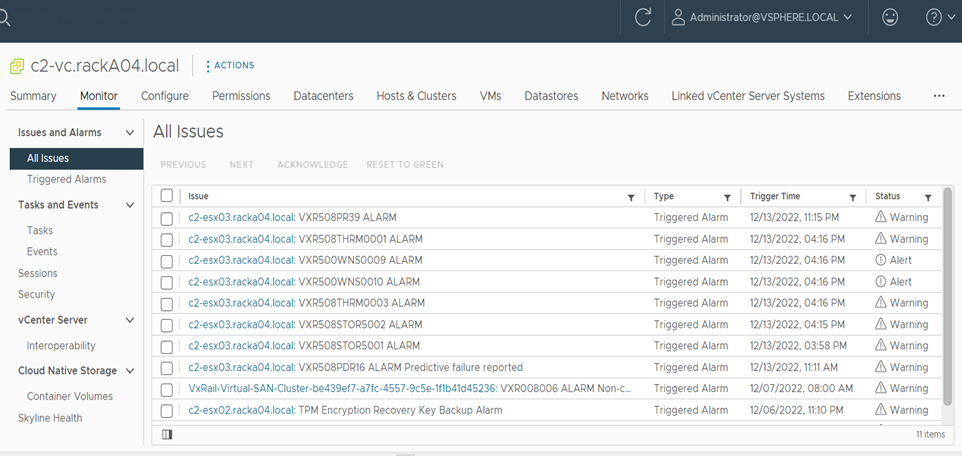
Figure 2. New iDRAC events displayed in the vCenter UI ‘All Issues’ view

Figure 3. New iDRAC events displayed in the VxRail Manager vCenter Plugin UI ‘Physical View’
Support for the capturing, displaying, and proactive dial home alerting for new iDRAC NIC port down events and alarms
To further improve system serviceability and simplify operations, VxRail 7.0.450 introduces the capturing of new iDRAC system events related to host NIC port link status. These include NIC port down warning events, each of which is indicated by a NIC100 event code and a ‘NIC port is started/up’ info event.
A NIC100 event indicates either that a network cable is not connected, or that the network device is not working.
A NIC101 event indicates that the transition from a network link ‘down’ state to a network link ‘started’ or ‘up’ state has been detected on the corresponding NIC port.
VxRail Manager now creates new VxM events that track these NIC port states.
As a result, users can be alerted through an alarm in vCenter when a NIC port is down. VxRail Manager will also generate a dial-home event when a NIC port is down. When the condition is no longer present, VxRail Manager will automatically clear the alarm by generating a clear-alarm event.
Finally, to reduce the number of false positive events and prevent unnecessary alarm and dial home events, VxRail Manager implements an intelligent throttling mechanism to handle situations in which false positive alarms related to network maintenance activities could occur. This makes the alarms/events that are triggered more credible for an admin to act against.
Table 1 contains a summary of the details of these two events and the VxRail Manager serviceability behavior.
Table 1. iDRAC NIC port down and started event and behavior details

Let’s double click on this serviceability behavior in a bit more detail.
Figure 4 depicts the behavior process flow VxRail Manager takes when iDRAC discovers and triggers a NIC port down system event. Let’s walk through the details now:
1. The first thing that occurs is that iDRAC discovers that the NIC port state has gone down and triggers a NIC port down event.
2. Next, iDRAC will send that event to VxRail Manager.
3. At this stage VxRail Manager will validate how long the NIC port down event has been active and check whether a NIC port started (or up) event has been triggered within a 30-minute time frame since the original NIC port down event occurred. With this check, if there has not been a NIC port started event triggered, VxRail Manager will begin throttling NIC port down event communication in order to prevent duplicate alerts about the same event.
If during the 30-minute window, a NIC port started event has been detected, VxRail Manager will cease throttling and clear the event.
4. When the VxRail Manager event throttling state is active, VxRail Manager will log it in its event history.
5. VxRail Manager will then trigger a vCenter alarm and post the event to vCenter.
6. Finally, VxRail Manager will trigger a NIC port down dial home event communication to backend Dell Support Systems, if connected.

Figure 4. Processing VxRail NIC port down events, and VxRail Manager throttling logic
Figure 5 shows what this looks like in the vCenter UI.
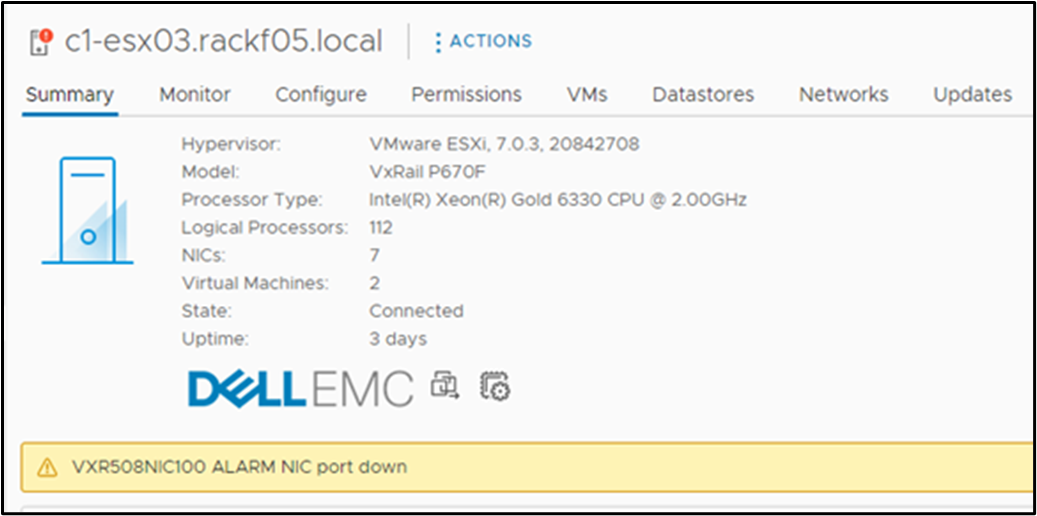
Figure 5. VxRail NIC port down trigger alarm in vCenter UI
Figure 6 shows what this looks like in the VxRail Manager vCenter Plugin ‘Physical View’ UI.
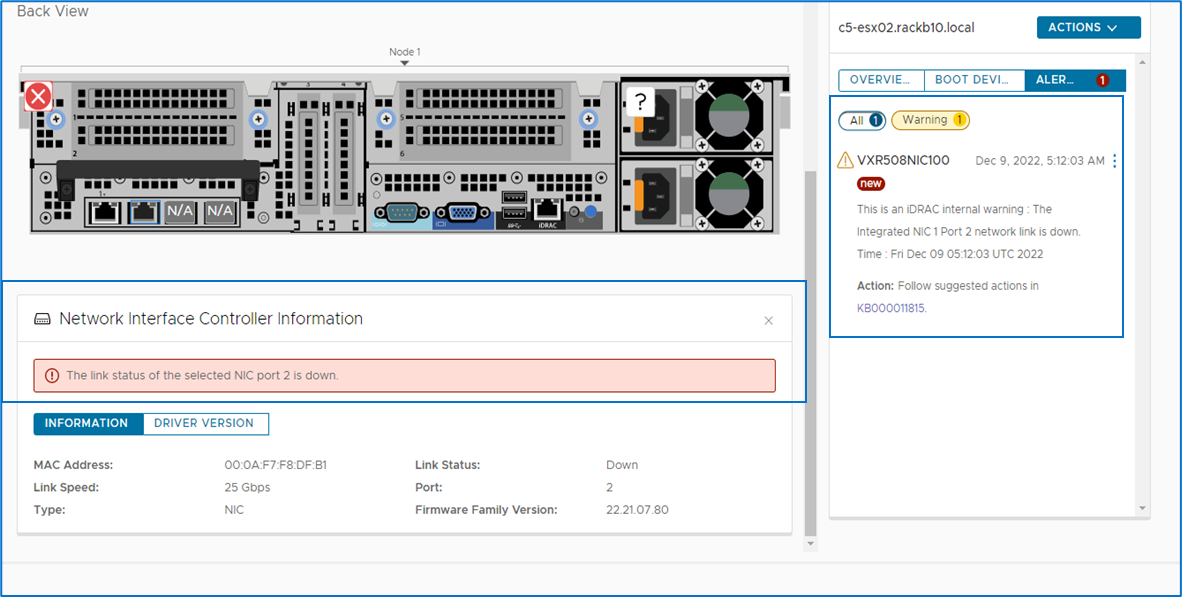
Figure 6. VxRail Manager vCenter Plugin ‘Physical View’ UI view of a VxRail NIC port down event
VCF on VxRail storage updates
Support for new PowerMax 2500 and 8500 storage arrays with VxRail 14G and 15G dynamic nodes using VMFS on FC principal storage
Starting in VCF 4.5.1 on VxRail 7.0.450, support has been added for the latest next gen Dell PowerMax 2500 and 8500 storage systems as VMFS on FC principal storage when deployed with 14G and 15G VxRail dynamic node clusters in VI workload domains.
Figure 7 lists the Dell storage arrays that support VxRail dynamic node clusters using VMFS on FC principal storage for VCF on VxRail, along with the corresponding supported FC HBA makes and models.
Note: Compatible supported array firmware and software versions are published in the Dell E-Lab Support Matrix for reference.
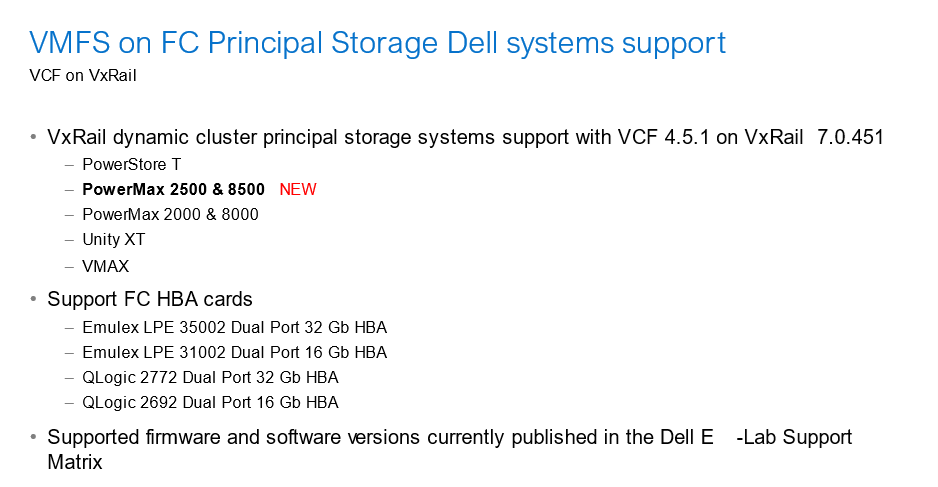
Figure 7. Supported Dell storage arrays used as VMFS on FC principal storage
VCF on VxRail lifecycle management enhancements
VCF Async Patch Tool 1.0.1.1 update
This tool addresses both LCM and security areas. Although it is not officially a feature of any specific VCF on VxRail release, it does get released asynchronously (pun intended) and is designed for use in VCF and VCF on VxRail environments. Thus, it deserves a call out.
For some background, the VCF Async Patch Tool is a new CLI based tool that allows cloud admins to apply individual component out-of-band security patches to their VCF on VxRail environment, separately from an official VCF LCM update release. This enables organizations to address security vulnerabilities faster without having to wait for a full VCF release update. It also allows admins to install these patches themselves without needing to engage support resources to get them applied manually.
With this latest AP Tool 1.0.1.1 release, the AP Tool now supports the ability to use patch VxRail (which includes all of the components in a VxRail update bundle including VxRail Manager and ESXi software components, and VxRail HW firmware/drivers) within VCF on VxRail environments. This is a great addition to the tool’s initial support for patching vCenter and NSX Manager in its first release. VCF on VxRail customers now have a centralized and standardized process for applying security patches for core VCF and VxRail software and core VxRail HCI stack hardware components (such as server BIOS or pNIC firmware/driver for example), all in a simple and integrated manner that VCF on VxRail customers have come to expect from a jointly engineered integrated turnkey hybrid cloud platform.
Note: Hardware patching is made possible due to how VxRail implements HW updates with the core VxRail update bundle. All VxRail patches for VxRail Manager, ESXi, and HW components are delivered in a the VxRail update bundle and leveraged by the AP Tool to apply.
From an operational standpoint, when patches for the respective software and hardware components have been applied, and a new VCF on VxRail BOM update is available that includes the security fixes, admins can use the tool to download the latest VCF on VxRail LCM release bundles and upgrade their environment back to an official in-band VCF on VxRail release BOM. After that, admins can continue to use the native SDDC Manager LCM workflow process for applying additional VCF on VxRail upgrades. Figure 8 highlights this process at a high level.
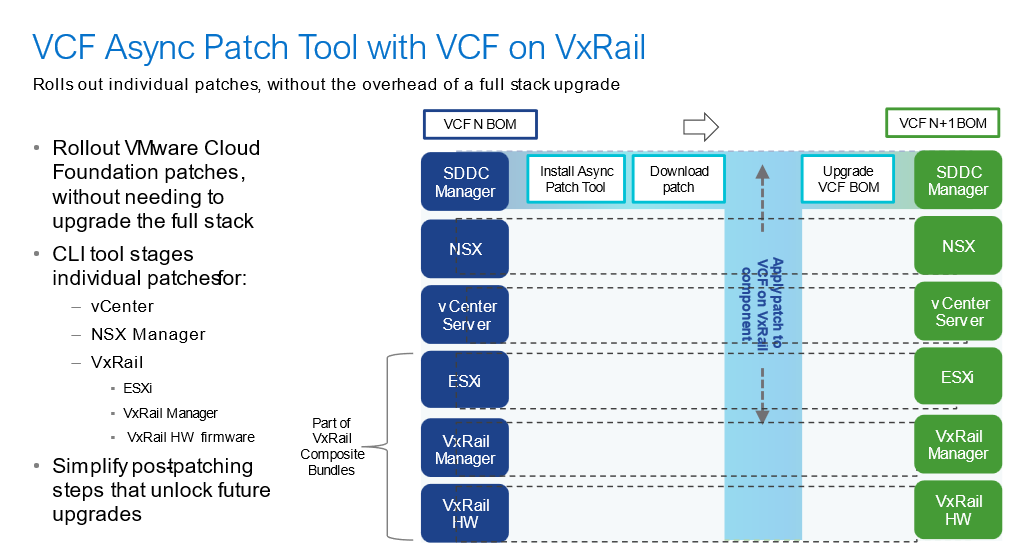
Figure 8. Async Patch Tool overview
You can access VCF Async Patch Tool instructions and documentation from VMware’s website.
Summary
In this latest release, the new features and platform improvements help set the stage for even more innovation in the future. For more details about bug fixes in this release, see VMware Cloud Foundation on Dell VxRail Release Notes. For this and other Cloud Foundation on VxRail information, see the following additional resources.
Author: Jason Marques
Twitter: @vWhipperSnapper
Additional Resources
- VMware Cloud Foundation on Dell VxRail Release Notes
- VxRail page on DellTechnologies.com
- VxRail Info Hub
- VCF on VxRail Interactive Demo
- Videos
Related Blog Posts
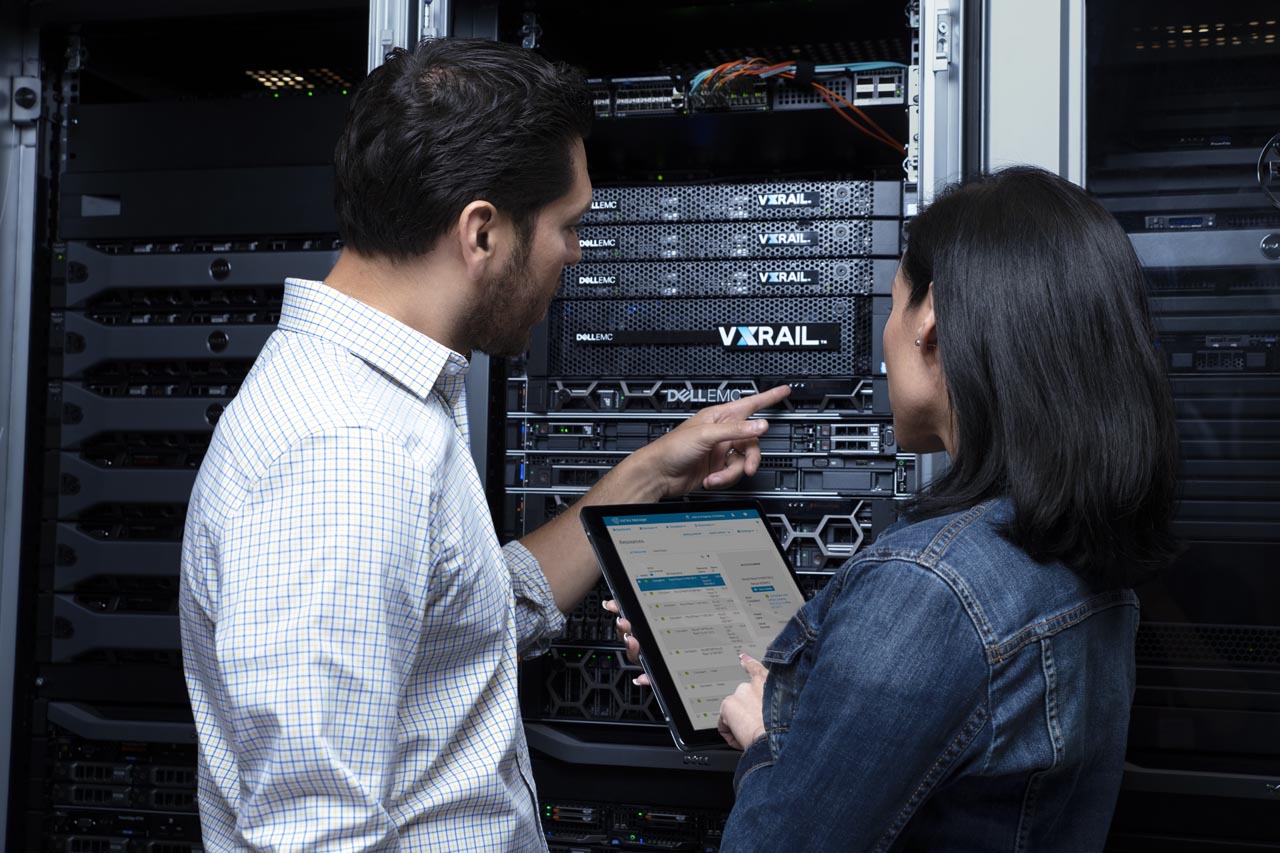
New Year’s Resolutions Fulfilled: Cloud Foundation on VxRail
Thu, 10 Feb 2022 13:24:57 -0000
|Read Time: 0 minutes
New Year’s Resolutions Fulfilled: VMware Cloud Foundation 4.4 on VxRail 7.0.320
Many of us make New Year’s resolutions for ourselves with each turn of the calendar. We hope everyone is still on track!
The Cloud Foundation on VxRail team wanted to establish our own resolutions too. And with that, Dell Technologies and VMware have come together to fulfill our resolution of continuing to innovate by making operating and securing cloud platforms easier for our customers while helping them unlock the power of their data.
And as a result, we are happy to announce the availability of our first release of the new year: VMware Cloud Foundation 4.4 on Dell VxRail 7.0.320! This release includes Cloud Foundation and VxRail software component version updates that include patches to some recent widely known security vulnerabilities. It also adds support for Dell ObjectScale on the vSAN Data Persistence Platform (vDPp), support for additional 15th generation VxRail platforms, new security hardening features, lifecycle management improvements, new Nvidia GPU workload support, and more. Phew! So be resolute and read on for the details.
VCF on VxRail Storage Enhancements
VCF on VxRail Lifecycle Management Enhancements
VCF on VxRail Hardware Platform Enhancements
VCF on VxRail Developer and AI-Ready Enterprise Platform Enhancements
VCF on VxRail Operations Enhancements
VCF on VxRail Security Enhancements
VCF on VxRail Storage Enhancements
Support for vSAN Data Persistence Platform and Dell ObjectScale Modern Stateful Object Storage Services
Initially introduced in vSphere 7.0 U1, the vSAN Data Persistence Platform (vDPp) is now supported as part of in VCF 4.4 on VxRail 7.0.320. Check out this great VMware blog post to learn more about vDPp.
Beginning in this release, support for running the new Dell ObjectScale data service on top of vDPp is also available. This new next-gen cloud native software defined object storage service is geared toward those IT teams who are looking to extend their cloud platform to run Kubernetes native stateful modern application data services. To learn more about ObjectScale please refer to this blog post. Note: VCF on VxRail currently supports using vDPp in a vSAN “Shared Nothing Architecture Mode” only.
The following figure illustrates the high-level architecture of vDPp.
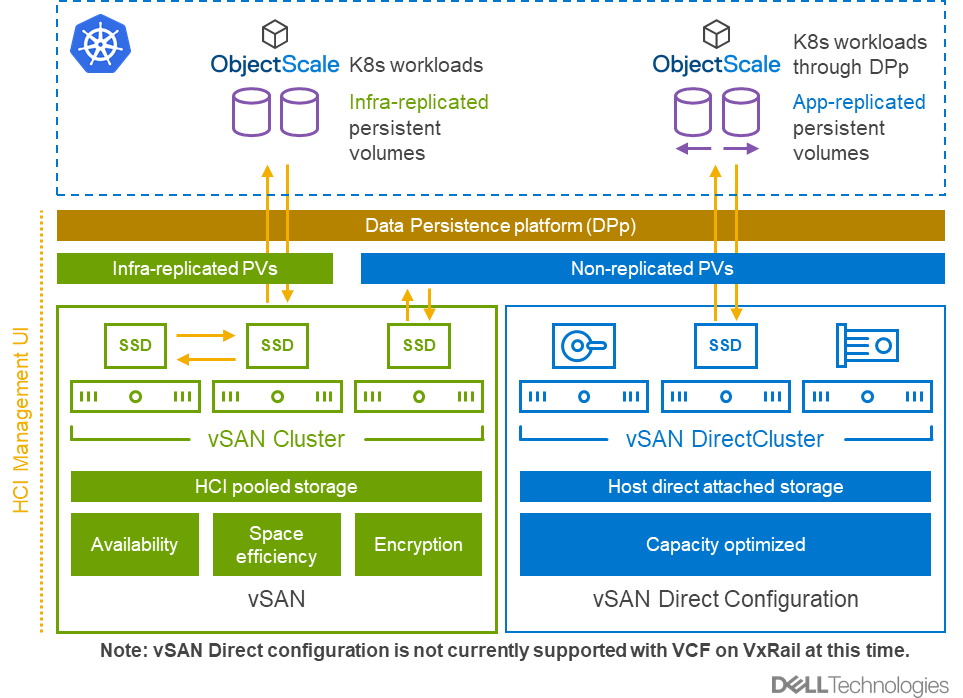
Figure 1 – vDPp and ObjectScale
As a result of this new capability, VCF on VxRail customers can further extend the storage flexibility the platform can support with S3 compatible object storage delivered as part of the turnkey cloud infrastructure management/operations experience.
Giving customers more storage flexibility resolution: Check!
VCF on VxRail Lifecycle Management Enhancements
Improved SDDC Manager LCM Prechecks
This release brings even more intelligence that is embedded into the SDDC Manager LCM precheck workflow. When performing an upgrade, the SDDC Manager needs to communicate to various components to complete various actions as well as requiring that certain system resources be configured correctly and are available.
To avoid any potential issues during LCM activities, VCF administrators can run SDDC Manager prechecks to weed any issues out before any LCM operation is executed. In this latest release SDDC Manager now adds six additional checks. These include:
- Password validity (including expired passwords)
- File system permissions
- File system capacity
- CPU reservation for NSX-T Managers
- Hosts in maintenance mode
- DRS configuration mode
All these checks apply to ESXi, vCenter, NSX-T, NSX-T Edge VMs, VxRail Manager, and vRealize Suite components in the VCF on VxRail environment. Figure 2 below illustrates some examples of what these prechecks look like from the SDDC Manager UI.
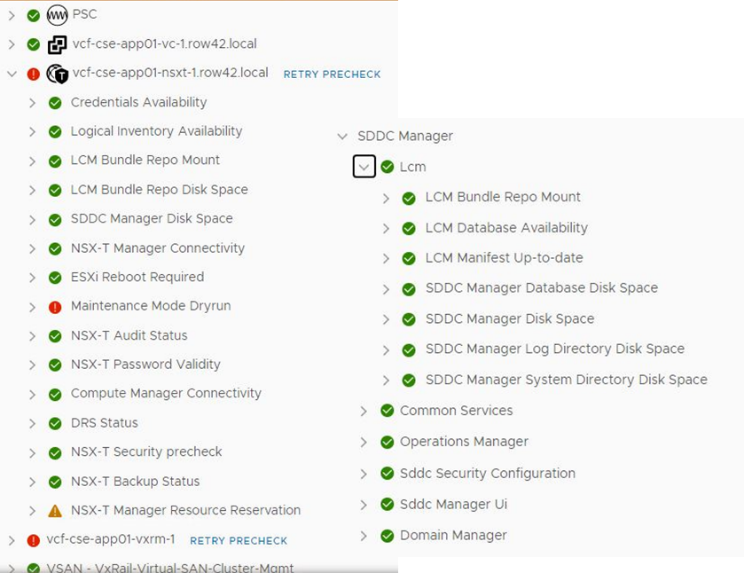
Figure 2 – New SDDC Manager Prechecks
Giving customers enhanced LCM improvements resolution: Check!
vRealize Suite Lifecycle Manager Flexible Upgrades
VCF 4.4 has been enhanced to allow vRealize suite products to be updated independently without having to upgrade the VCF SDDC stack.
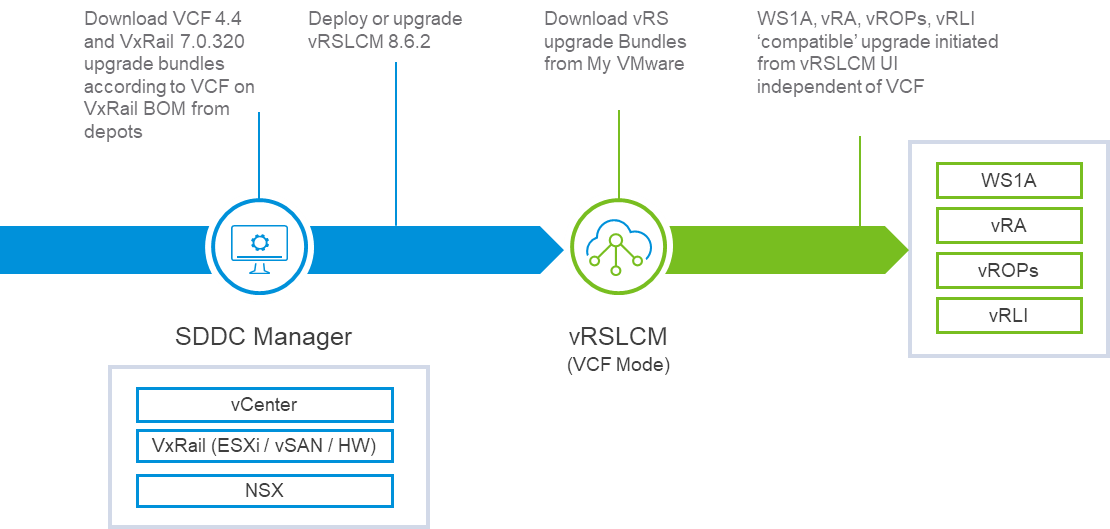
Figure 3 – vRSLCM Flexible Upgrades
This means that from VCF 4.4 on, administrators will use vRSLCM to manage vRealize Suite update bundles and orchestrate and apply those upgrades to vRealize Suite products (vRealize Automation, vRealize Operations, vRealize Log Insight, Workspace ONE Access, and more) independently from the core VCF version upgrade to help better align with an organization’s business requirements. It also helps decouple VCF infrastructure team updates from DevOps team updates enabling teams to consume new vRealize features quickly. And finally, it enables an independent update cadence between VCF and vRealize versions which boosts and improves interoperability flexibility. And who doesn’t like flexibility? Am I right?
One last note with this enhancement: SDDC Manager will no longer be used to manage vRealize Suite component update bundles and orchestrate vRealize Suite component LCM updates. With this change, future versions of VCF will not include vRealize Suite components as part of its software components. vRSLCM will still be a part of VCF software components validated for compatibility for each VCF release since that will continue to be deployed and updated using SDDC Manager. As such, SDDC Manager continues to manage vRSLCM install and update bundles just as it has done up to this point.
Giving customers enhanced LCM flexibility resolution: Check!
VCF on VxRail Hardware Platform Enhancements
Support For New 15th Generation Intel-Based VxRail Dynamic Node Platforms
VxRail 7.0.320 includes support for the latest 15th Generation VxRail dynamic nodes for the E, P, and V series models. These can be used when deploying VMFS on FC Principal storage VxRail VI Workload Domain clusters. Figure 4 below highlights details for each model.
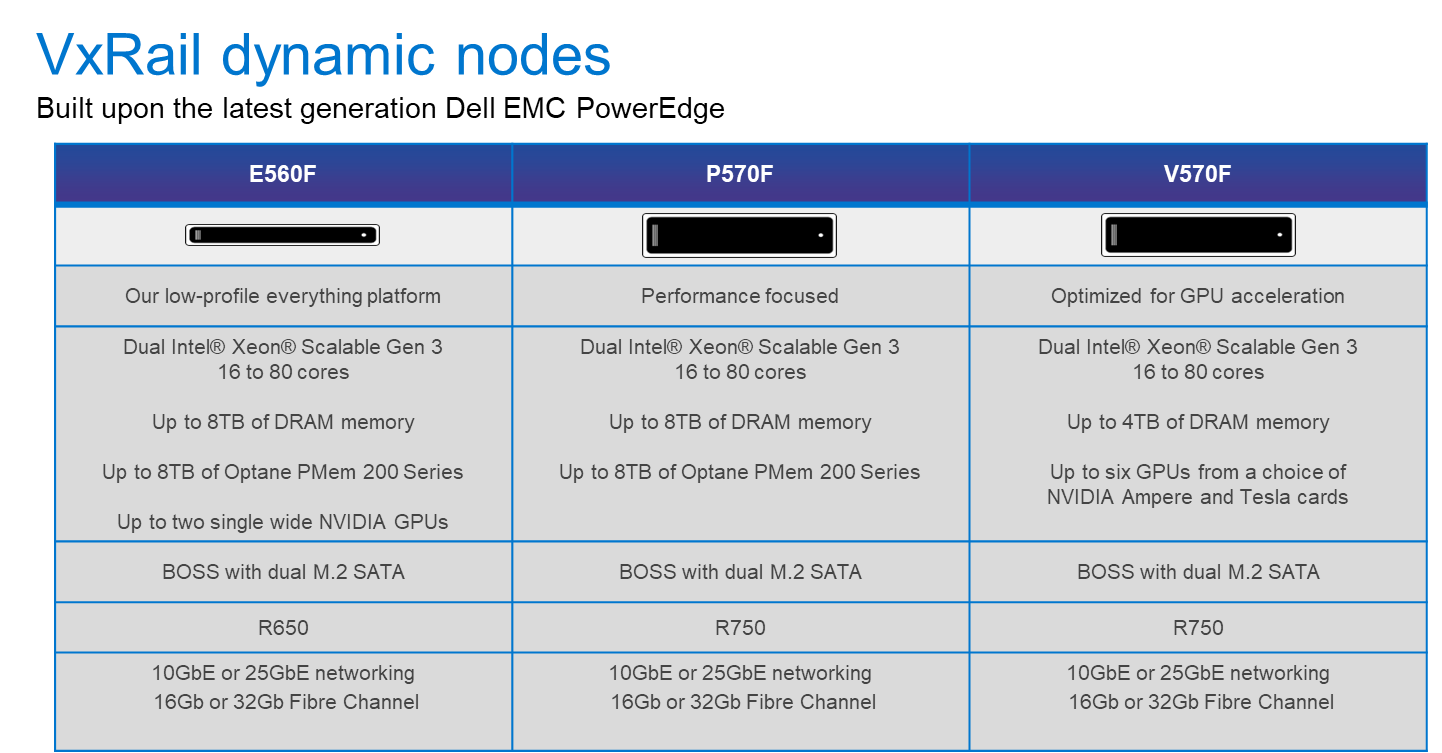
Figure 4 – New 15th Generation VxRail dynamic node models
Also, as it relates to using VxRail dynamic nodes when deploying VMFS on FC Principal storage, support for using NVMe over FC configurations has also been introduced since it is a part of the VxRail 7.0.320 release that VCF on VxRail customers can just inherit from VxRail. It’s like finding a fifth chicken nugget in the bag after ordering the four-piece meal! Wait, it is New Year’s—I should have used a healthier food example. Oops!
Support For New 15th Generation Intel-Based VxRail With vSAN Platforms (S670 and E660N)
In addition to new 15th generation dynamic nodes, this release introduces support for two new 15th generation VxRail node types, the S670 and E660N. The S670 is our 2U storage density optimized hybrid platform based on the PowerEdge R750 while the E660N is our 1U “everything” all NVMe platform based on the PowerEdge R650.
Giving customers more hardware platform choices resolution: Check!
VCF on VxRail Developer and AI-Ready Enterprise Platform Enhancements
NVIDIA GPU Options for AI and ML Workload Use Cases
As AI and ML applications are becoming more critical within organizations, IT teams are looking at the best approaches to run them within their own data centers to ensure ease of manageability and scale, improved security, and maintaining governance.
As a follow on to the innovative and collaborative partnerships between Dell Technologies, VMware, and NVIDIA that were first introduced at VMworld 2021, we are happy to announce, with this VCF on VxRail release, the ability to run GPUs within VMware Cloud Foundation 4.4 on VxRail 7.0.320 to deliver an end-to-end AI-Ready enterprise platform that is simple to deploy and operate.
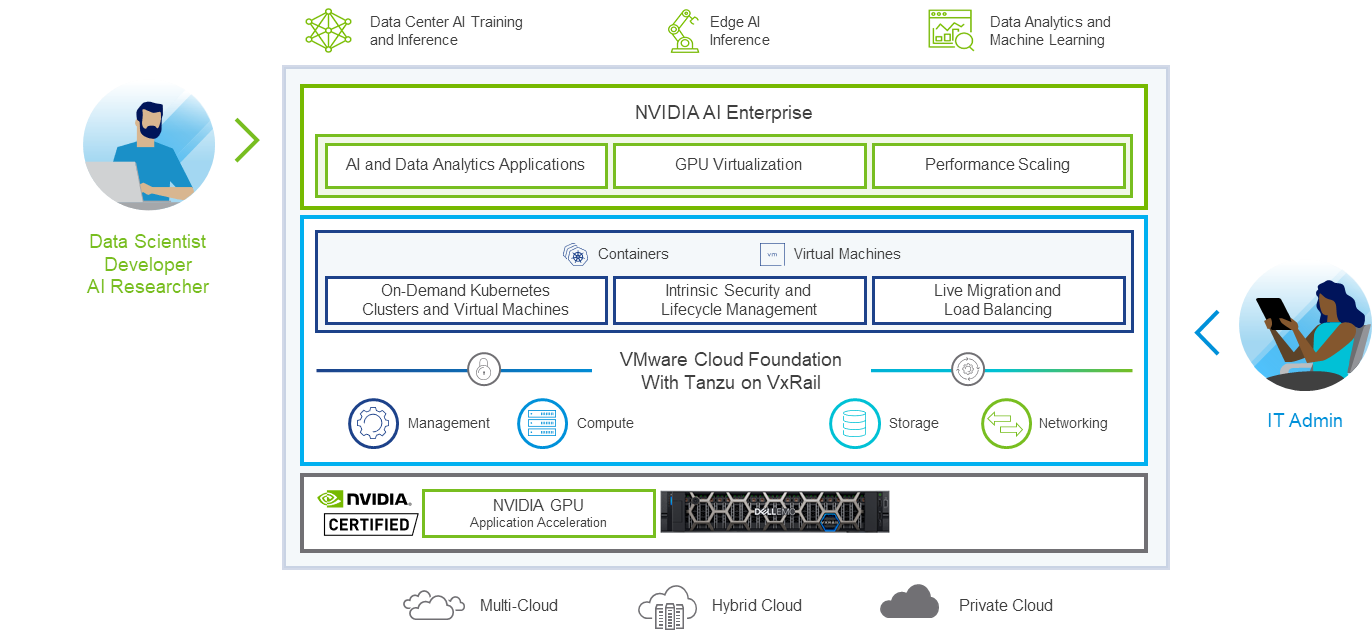
Figure 5 – VCF with Tanzu on VxRail + NVIDIA AI-Ready Enterprise Platform
VMware Cloud Foundation with Tanzu, when used together with NVIDIA certified systems like VxRail and NVIDIA AI Enterprise Suite software, deliver an end-to-end AI / ML enterprise platform. And with VxRail being the first and only HCI Integrated System certified with NVIDIA AI Enterprise Suite and its supported GPUs, IT teams can deliver and provision GPU resources quickly in a variety of ways, while also allowing data scientists to easily consume and scale GPU resources quickly when they need it.
While getting into all the details on getting this set up is beyond the scope of this blog post, you can find more information on using NVIDIA GPUs with VxRail and NVIDIA AI Enterprise Software Suite using the link at the end of this post. VMware has additional information about this new support in a blog post that you can check out using the link at the bottom of this page.
Giving customers a simple path to unlock the power of their data resolution: Check!
VCF on VxRail Operations Enhancements
Configure DNS/NTP From SDDC Manager UI
This new feature simplifies and streamlines DNS and NTP Day 2 management operations for cloud administrators. In previous releases, all DNS and NTP configuration was included in the VCF Bring Up Parameter file that was used by Cloud Builder at the time of VCF on VxRail installation. But there was no straightforward way to make updates or changes to these settings once VCF on VxRail has been deployed. Now, if additional modifications are needed to these configurations, they can be performed within the SDDC Manager UI as a simple Day 2 operation. This feature integrates SDDC Manager with native VxRail APIs to automate VxRail cluster DNS/NTP settings. The figure below shows what this looks like.
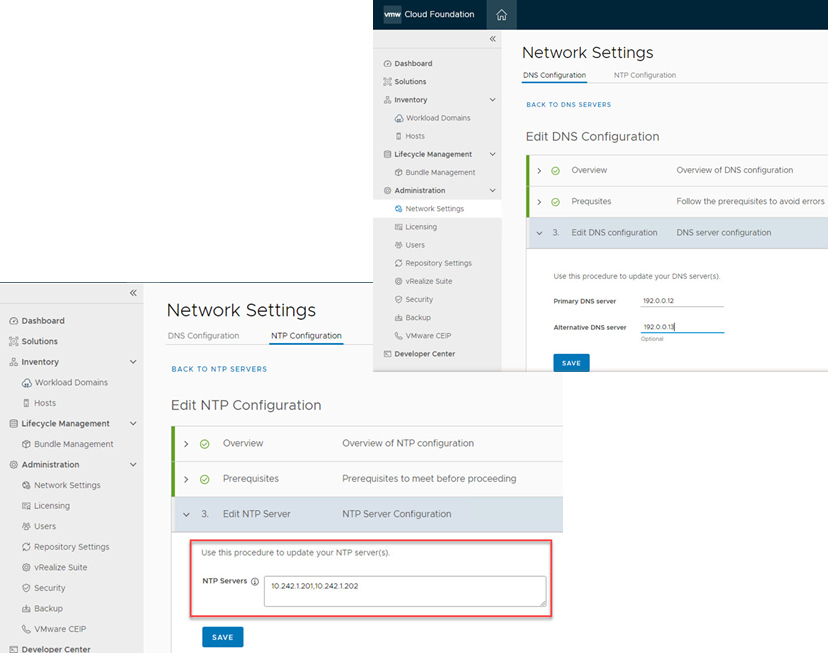
Figure 6 – DNS/NTP Day 2 Configuration From SDDC Manager UI
Giving customers a simpler and more flexible day 2 operations experience resolution: Check!
VCF on VxRail Security Enhancements
Activity Logging For VCF REST API Call-Driven Actions
Administrators can now ensure audit tracking for activity that takes place using the VCF REST API. In this release, SDDC Manager logs capture SDDC Manager API activity from SDDC Manager UI and other sources with user context. This can be used to ensure audit tracking of VCF activity and making analyzing logs easier to understand. Figure 5 below illustrates this activity. The log entries include the following data points:
- Timestamp
- Username
- Client IP
- User agent
- API called
- API method
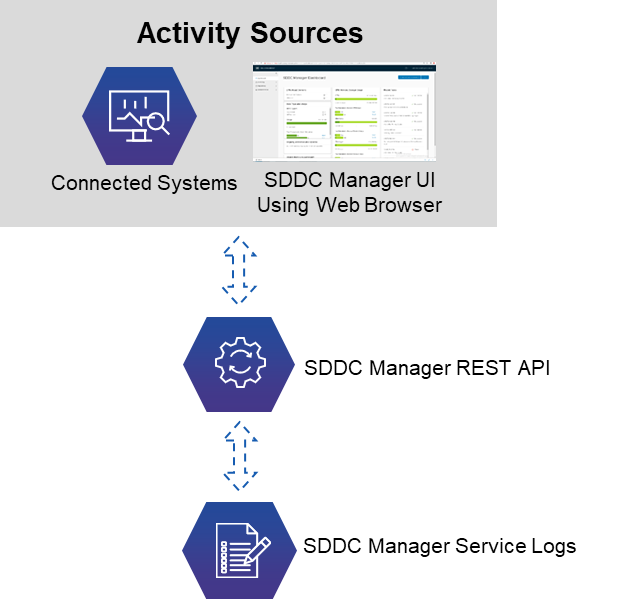
Figure 7 – SDDC Manager REST API Activity Logging
Each of the SDDC Manager core services has a dedicated activity log. These logs are in the respective /var/log/vmware/vcf/*service*/ service directories on the SDDC Manager VM.
Giving customers enhanced security logging resolution – Check!
Enhanced Access Security Hardening
This release disables the SSH service on ESXi hosts by default, following the vSphere security configuration guide recommendation.
This applies to new and upgraded VMware Cloud Foundation 4.4 on VxRail 7.0.320 deployments.
Giving customers enhanced default platform security hardening resolution: Check!
Log4j and Apache HTTP Server Fixes
No security conversation is complete without addressing the headache that has been the talk of the technology world recently and that is the Log4j and Apache HTTP Server vulnerability discoveries. VCF on VxRail customers can be rest assured that as a part of this release fixes for these vulnerabilities are included.
Kicking Log4j and Apache HTTP bugs to the curb resolution: Check!
To wrap up…
Well, that about covers it for this new batch of updates. For the full list of new features, please refer to the release notes listed below. There are additional resource links at the bottom of this post. We hope to continue making good on our VCF on VxRail platform resolutions throughout the year! Hopefully, we all can say the same for ourselves in other areas of our lives. Now, where is that treadmill...?
Author: Jason Marques
Twitter: @vWhipperSnapper
Additional resources
VMware Cloud Foundation on Dell VxRail Release Notes
VxRail page on DellTechnologies.com
Virtualizing GPUs for AI Workloads with NVIDIA AI Enterprise Suite and VxRail Whitepaper
VMware Blog Post on new VCF 4.4 support of NVIDIA AI Enterprise Suite and GPUs

Announcing VMware Cloud Foundation 5.0 on Dell VxRail 8.0.100
Thu, 22 Jun 2023 13:00:59 -0000
|Read Time: 0 minutes
A more flexible and scalable hybrid cloud platform with simpler upgrades from previous releases
The latest release of the co-engineered turnkey hybrid cloud platform is now available, and I wanted to take this great opportunity to discuss its enhancements.
Many new features are included in this major release, including support for the latest VCF and VxRail software component versions based on the latest vSphere 8.0 U1 virtualization platform generation, and more. Read on for the details!
In-place upgrade lifecycle management enhancements
Support for automated in-place upgrades from VCF 4.3.x and higher to VCF 5.0
This is the most significant feature our customers have been waiting for. In the past, due to significant architectural changes between major VCF releases and their SDDC components (such as NSX), a migration was required to move from one major version to the next. (Moving from VCF 4.x to VCF 5.x is considered a major version upgrade.) In this release, this type of upgrade is now drastically improved.
After the SDDC Manager has been upgraded to version 5.0 (by downloading the latest SDDC Manager update bundle and performing an in-place automated SDDC Manager orchestrated LCM update operation), an administrator can follow the new built-in SDDC Manager in-place upgrade workflow. The workflow is designed to assist in upgrading the environment without needing any migrations. Domains and clusters can be upgraded sequentially or in parallel. This reduces the number and duration of maintenance windows, allowing administrators to complete an upgrade in less time. Also, VI domain skip-level upgrade support allows customers to run VCF 4.3.x or VCF 4.4.x BOMs in their domains to streamline their upgrade path to VCF 5.0, by skipping intermediary VCF 4.4.x and 4.5.x versions respectively. All this is performed automatically as part of the native SDDC Manager LCM workflows.
What does this look like from the VCF on VxRail administrator’s perspective? The administrator is first notified that a new SDDC Manager 5.0 upgrade is available. Administrators will be guided first to update their SDDC Manager instance to version 5.0. With SDDC Manager 5.0 in place, administrators can take advantage of the new enhancements which streamline the in-place upgrade process that can be used for the remaining components in the environment. These enhancements follow VMware best practices, reduce risk, and allow administrators to upgrade the full stack of the platform in a staged manner. These enhancements include:
- Context aware prechecks
- vRealize Suite prechecks
- Config drift awareness
- vCenter Server migration workflow
- Licensing update workflow
The following image highlights part of the new upgrade experience from the SDDC Manager UI. First, on the updates tab for a given domain, we can see the availability of the upgrade from VCF 4.5.1 to VCF 5.0.0 on VxRail 8.0.100 (Note: In this example, the first upgrade bundle for the SDDC Manager 5.0 was already applied.)
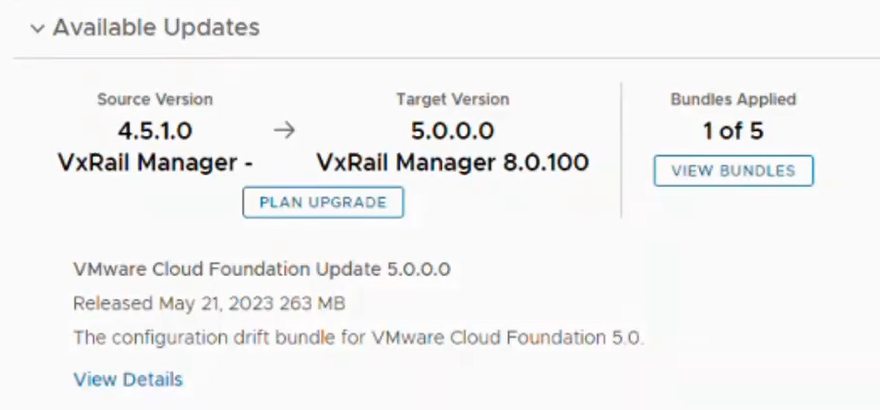
When the administrator clicks View Bundles, SDDC Manager displays a high-level workflow that highlights the upgrade bundles that would be applied, and in which order.

To see the in-place upgrade in action, check out the following demo:
Now let’s dive a little deeper into the upgrade workflow steps. The following diagram depicts the end-to-end workflow for performing an in-place LCM upgrade from VCF 4.3.x/4.4.x/4.5.x to VCF 5.0 for the management domain.
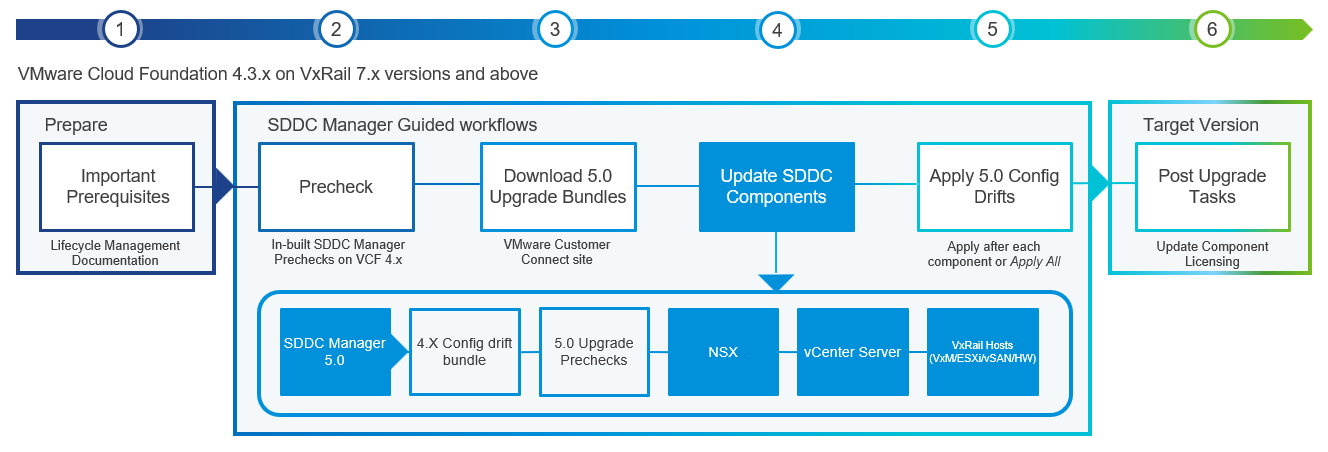
The in-place upgrade workflow for the management domain consists of the following six steps:
- Plan and prepare by ensuring all important prerequisites are met (for example, the minimum supported VCF on VxRail version for an in-place upgrade is validated, in-place upgrade supported topologies are being used, and so on).
- Run an update precheck and resolve any issues before starting the upgrade process.
- Download the VMware Cloud Foundation and VxRail Upgrade Bundles from the Online Depot within SDDC Manager using a MyVMware account and a Dell support online depot account respectively.
- Upgrade components using the automated guided workflow, including SDDC Manager, NSX-T Data Center, vCenter Server for VCF, and VxRail hosts.
- Apply configuration drifts, which capture required configuration changes between release versions.
- When the upgrade is completed, update component licensing using the built-in SDDC Manager workflow (only applicable for VCF instances deployed using perpetual licensing).
Upgrading workload domains follows a similar workflow.
If performed manually, the in-place upgrade process to VCF 5.0 on VxRail 8.0.100 from previous releases would be potentially error-prone and time-consuming. The guided, simplified, and automated experience now provided in SDDC Manager 5.0 greatly reduces the effort and risk for customers, by helping them perform this operation in a fully controlled, guided, and automated manner on their own, providing a much better user experience and better value.
SDDC Manager context aware prechecks
Keeping a large-scale cloud environment in a healthy, well-managed state is very important to achieve the desired service levels and increase the success rate of LCM operations. In SDDC Manager 5.0, prechecks have been further enhanced and are now context aware. But what does this mean?
Before performing the upgrade, administrators can choose to run a precheck against a specific VCF release (“Target Version”) or run a “General Update Readiness” precheck. Each type of precheck allows the administrator to select the specific VCF on VxRail objects to run the precheck on. For example, an administrator can run it against an entire domain, a VxRail cluster, or even an individual SDDC software component such as NSX and vRealize/Aria Suite components. For example, a precheck can be run at a per-VxRail cluster level, which might be useful for large workload domains configured with multiple clusters. It could reduce planned maintenance windows by updating components of the domain separately.
But what is the difference between the “Target Version” and “General Upgrade Readiness” precheck types? Let me explain:
- Target Version precheck - Prechecks for a specific “Target Version” will run prechecks related to the components between the source and target VCF on VxRail release. (Note that the drop-down in the SDDC Manager UI will only show target versions from VCF 5.x on VxRail 8.x after the SDDC Manager has been updated to 5.0). This feature reduces the risk of issues during the upgrade to the target VCF release.
- General Upgrade Readiness precheck - The “General Upgrade Readiness” precheck can be run any time to plan and assess upgrade readiness without triggering the upgrade. The “General Upgrade Readiness” precheck can periodically run as a health check on a given SDDC component.
The following screenshot shows what this feature looks like from the system administrator perspective in the SDDC Manager UI:

Platform security and scalability enhancements
Isolated domains with individual SSO
Another significant new feature I’d like to highlight is the introduction of Isolated workload domains. This has a significant impact on both the security and scalability of the platform.
In the past, VMware Cloud Foundation 4.x deployments by design have been configured to use a single SSO instance shared between the management domain and all VI workload domains (WLDs). All WLDs’ vCenter Servers are connected to each other using Enhanced Linked Mode (ELM). After a user is logged into SDDC Manager, ELM provides seamless access to all the products in the stack without being challenged to authenticate again.
VCF 5.0 on VxRail 8.0.100 deployments allow administrators to configure new workload domains using separate SSO instances. These are known as Isolated domains. This capability can be very useful, especially for Managed Service Providers (MSPs) who can allocate Isolated workload domains to different tenants with their own SSO domains for better security and separation between the tenant environments. Each Isolated SSO domain within VCF 5.0 on VxRail 8.0.100 is also configured with its own NSX instance.
As a positive side effect of this new design, the maximum number of supported domains per VCF on VxRail instance has now been increased to 25 (this includes the management domain and assumes all workload domains are deployed as isolated domains). This scalability enhancement results from not hitting the max number of vCenters configured in an ELM instance (which is 15) because Isolated domains are not configured with ELM with the management SSO domain. So, increasing the security and separation between the workload domains can also increase the overall scalability of the VCF on VxRail cloud platform.
The following diagram illustrates how customers can increase the scalability of the VCF on VxRail platform by adding isolated domains with their dedicated SSO:
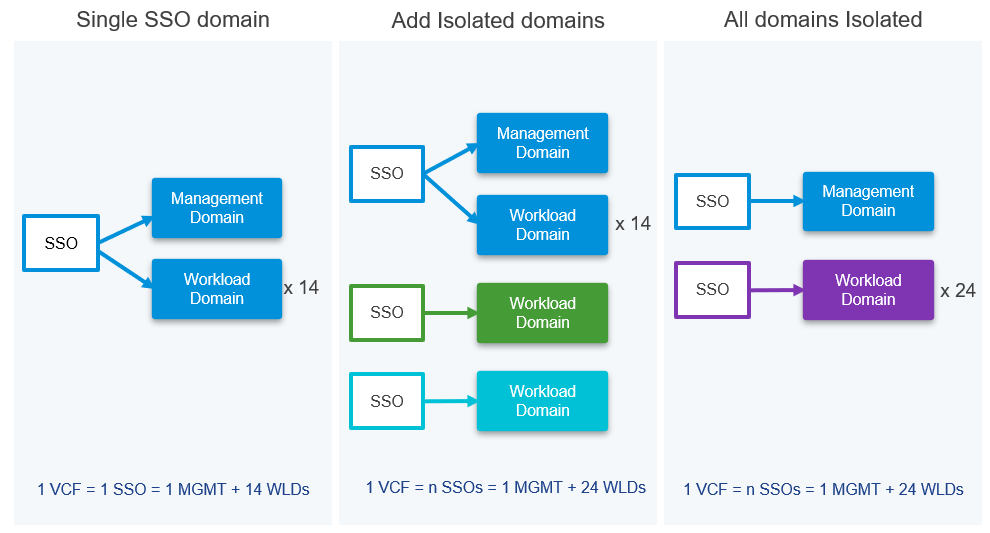
What does this new feature look like from the VCF on VxRail administrator’s perspective?
When creating a new workload domain, there’s a new option in the UI wizard allowing either to join the new WLD into the management SSO domain or create a new SSO domain:
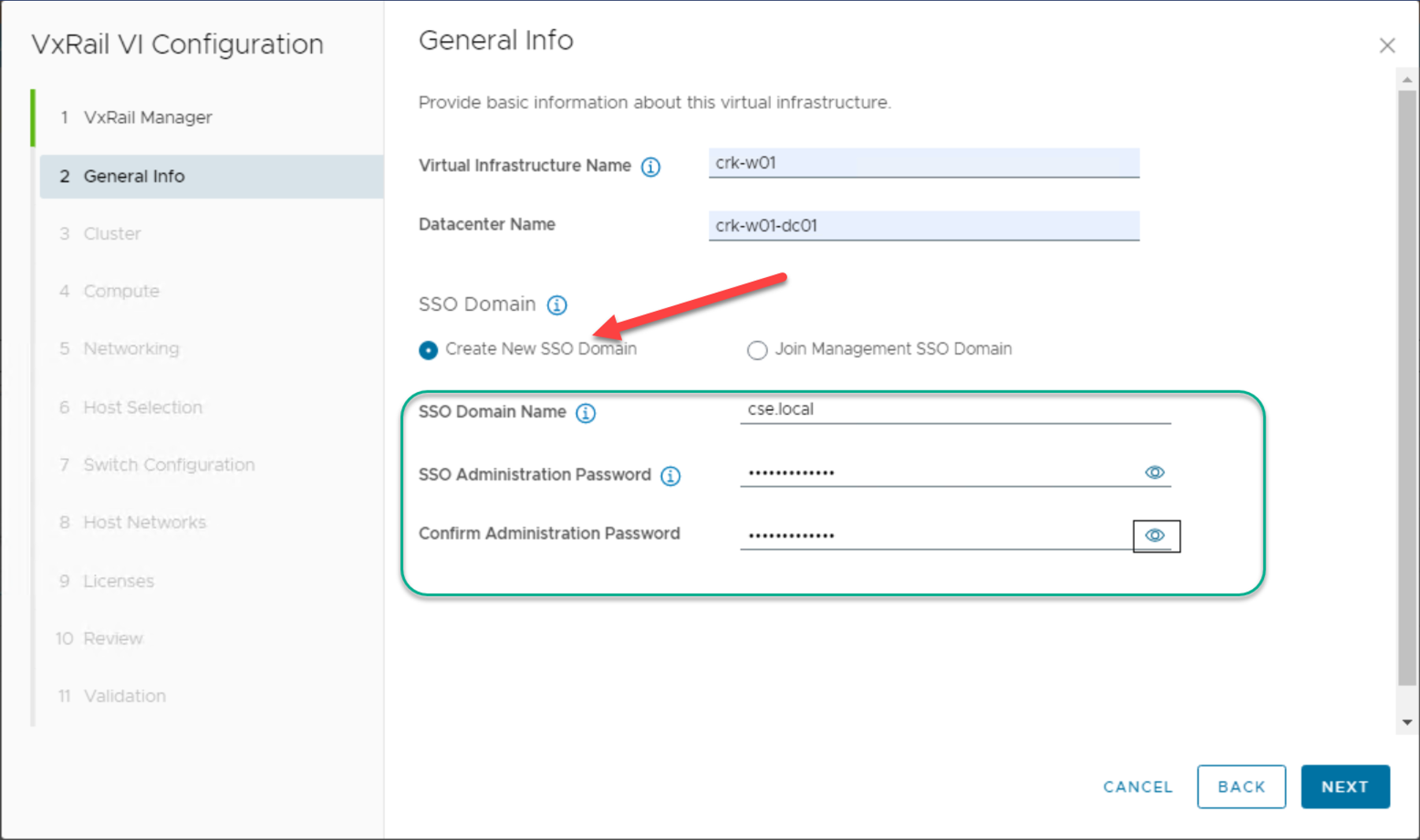
After the SSO domain is created, its information is shown in the workload domain summary screen:
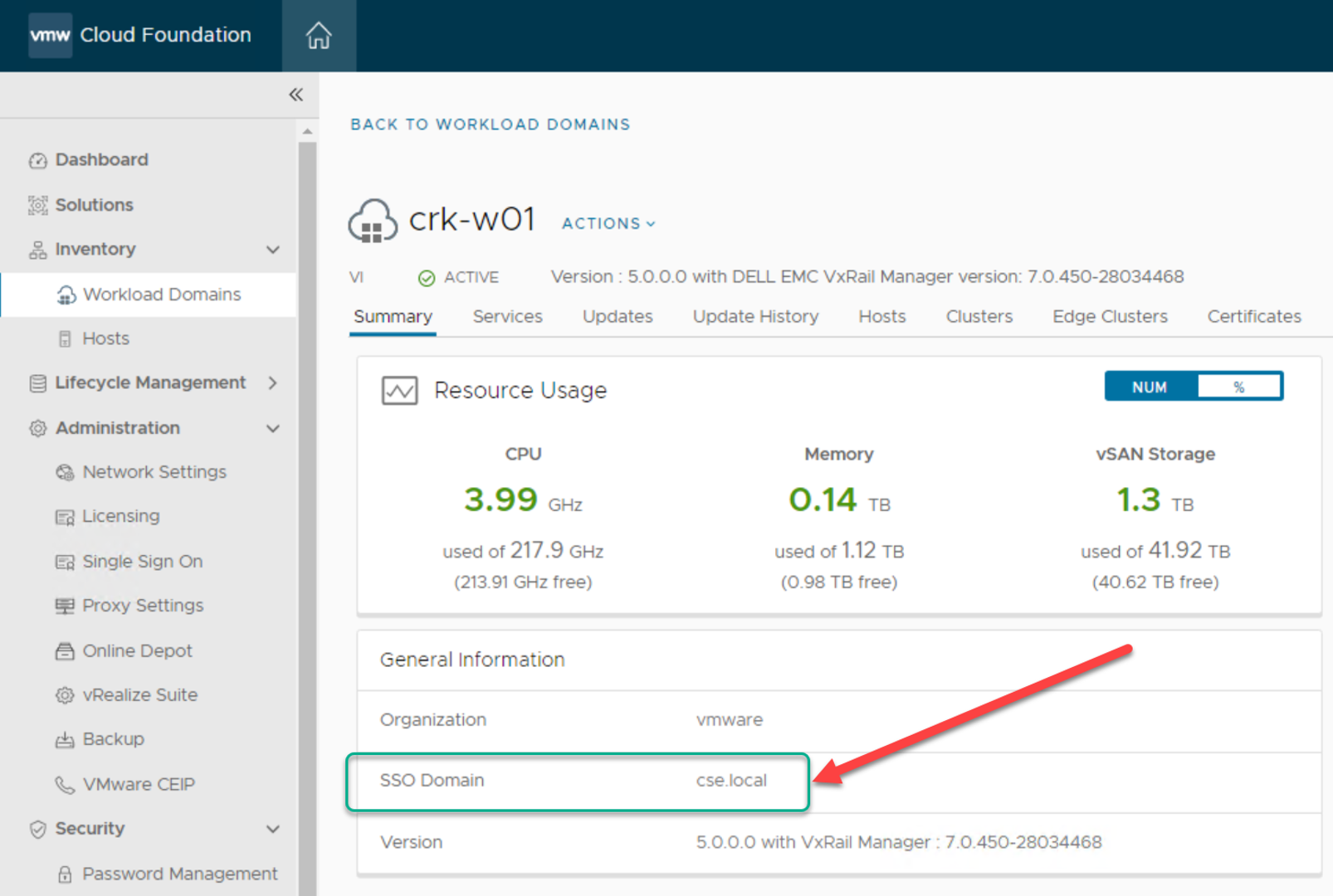
General LCM updates
VxRail accurate versioning support and SDDC Manager ‘Release Versions’ UI and API enhancements
These two features should be discussed together. Beginning in VCF 5.0 on VxRail 8.0.100 and higher, enhancements were made to the SDDC Manager LCM service that enables more granular compatibility and tracking of current and previous VxRail versions that are compatible with current and previous VCF versions. This opens VCF on VxRail to be more flexible by supporting different VxRail versions within a given VCF release. It allows admins to support applying and tracking asynchronous VxRail release patches outside of the 1:1 mapped, fully compatible VCF on VxRail release that could require waiting for it to be available. This information about available and supported release versions for VCF and VxRail is integrated into the SDDC Manager UI and API.
Flexible WLD target versions
VCF 5.0 on VxRail 8.0.100 introduces the ability for each workload domain to have different versions as far back as N-2 releases, where N is the current version on the management domain. With this new flexibility, VCF on VxRail administrators are not forced to upgrade workload domain versions to match the management domain immediately. In the context of VCF 5.0 on VxRail 8.0.100, this can help admins plan upgrades over a long period of time when maintenance windows are tight.
SDDC Manager config drift awareness
Each VMware Cloud Foundation release introduces several new features and configuration changes to its underlying components. Update bundles contain these configuration changes to ensure an upgraded VCF on VxRail instance will function like a greenfield deployment of the same version. Configuration drift awareness allows administrators to view parameters and configuration changes as part of the upgrade. An example of configuration drift is adding a new service account or ESXi lockdown enhancement. This added visibility helps customers better understand new features and capabilities and their impact on their deployments.
The following screenshot shows how this new feature appears to the administrator of the platform:

SDDC Manager prechecks for vRealize/Aria Suite component versions
SDDC Manager 5.0 allows administrators to run a precheck for vRealize/VMware Aria Suite component compatibility. The vRealize/Aria Suite component precheck is run before upgrading core SDDC components (NSX, vCenter Server, and ESXi) to a newer VCF target release, and can be run from VCF 4.3.x on VxRail 7.x and above. The precheck will verify if all existing vRealize/Aria Suite components will be compatible with core SDDC components of a newer VCF target release by checking them against the VMware Product Interoperability Matrix.
General security updates
Enhanced certificate management
VCF 5.0 on VxRail 8.0.100 contains improved workflows that orchestrate the process of configuring Certificate Authorities and Certificate Signing Requests. Administrators can better manage certificates in VMware Cloud Foundation, with improved certificate upload and installation, and new workflows to ensure certificate validity, trust, and proper installation. These new workflows help to reduce configuration time and minimize configuration errors.
Storage updates
Support for NVMe over TCP connected supplemental storage
Supplemental storage can be used to add storage capacity to any domain or cluster within VCF, including the management domain. It is configured as a Day 2 operation. What’s new in VCF 5.0 on VxRail 8.0.100 is the support for the supplemental storage to be connected with the NVMe over TCP protocol.
Administrators can benefit from using NVMe over TCP storage in a standard Ethernet-based networking environment. NVMe over TCP can be more cost-efficient than NVMe over FC and eliminates the need to deploy and manage a fiber channel fabric if that is what an organization requires.
Operations and serviceability updates
VCF+ enhancements
VMware Cloud Foundation+ has been enhanced for the VCF 5.0 release, allowing greater scale and integrated lifecycle management. First, the scalability increased – it allows administrators to connect up to eight domains per VCF instance (including the management domain) to the VMware Cloud portal. Second, updates to the Lifecycle Notification Service within the VMware Cloud portal provide visibility of pending updates to any component within the VCF+ Inventory. Administrators can initiate updates through the VCF+ Lifecycle Management Notification Service, which connects back to the specific SDDC Manager instance to be updated. From here, administrators can use familiar SDDC Manager prechecks and workflows to update their environment.
VxRail hardware platform updates
Support for single socket 15G VxRail P670F
A new VxRail hardware platform is now supported, providing customers more flexibility and choice. The single-socket VxRail P670F, a performance-focused platform, is now supported in VCF on VxRail deployments and can offer customers savings on software licensing in specific scenarios.
Other asynchronous release related updates
VCF Async Patch Tool 1.1.0.1 release
While not directly tied to VCF 5.0 on VxRail 8.0.100 release, VMware has also released the latest version of the VCF Async Patch Tool. This latest version now supports applying patches to VCF 5.0 on VxRail 8.0.100 environments.
Summary
VMware Cloud Foundation 5.0 on Dell VxRail 8.0.100 is a new major platform release based on the latest generation of VMware’s vSphere 8 hypervisor. It provides several exciting new capabilities, especially around automated upgrades and lifecycle management. This is the first major release that provides guided, simplified upgrades between the major releases directly in the SDDC Manager UI, offering a much better experience and more value for customers.
All of this makes the new VCF on VxRail release a more flexible and scalable hybrid cloud platform, with simpler upgrades from previous releases, and lays the foundation for even more beneficial features to come.
Author: Karol Boguniewicz, Senior Principal Engineering Technologist, VxRail Technical Marketing
Twitter: @cl0udguide
Additional Resources:
VMware Cloud Foundation on Dell VxRail Release Notes
VxRail page on DellTechnologies.com
VCF on VxRail Interactive Demo




